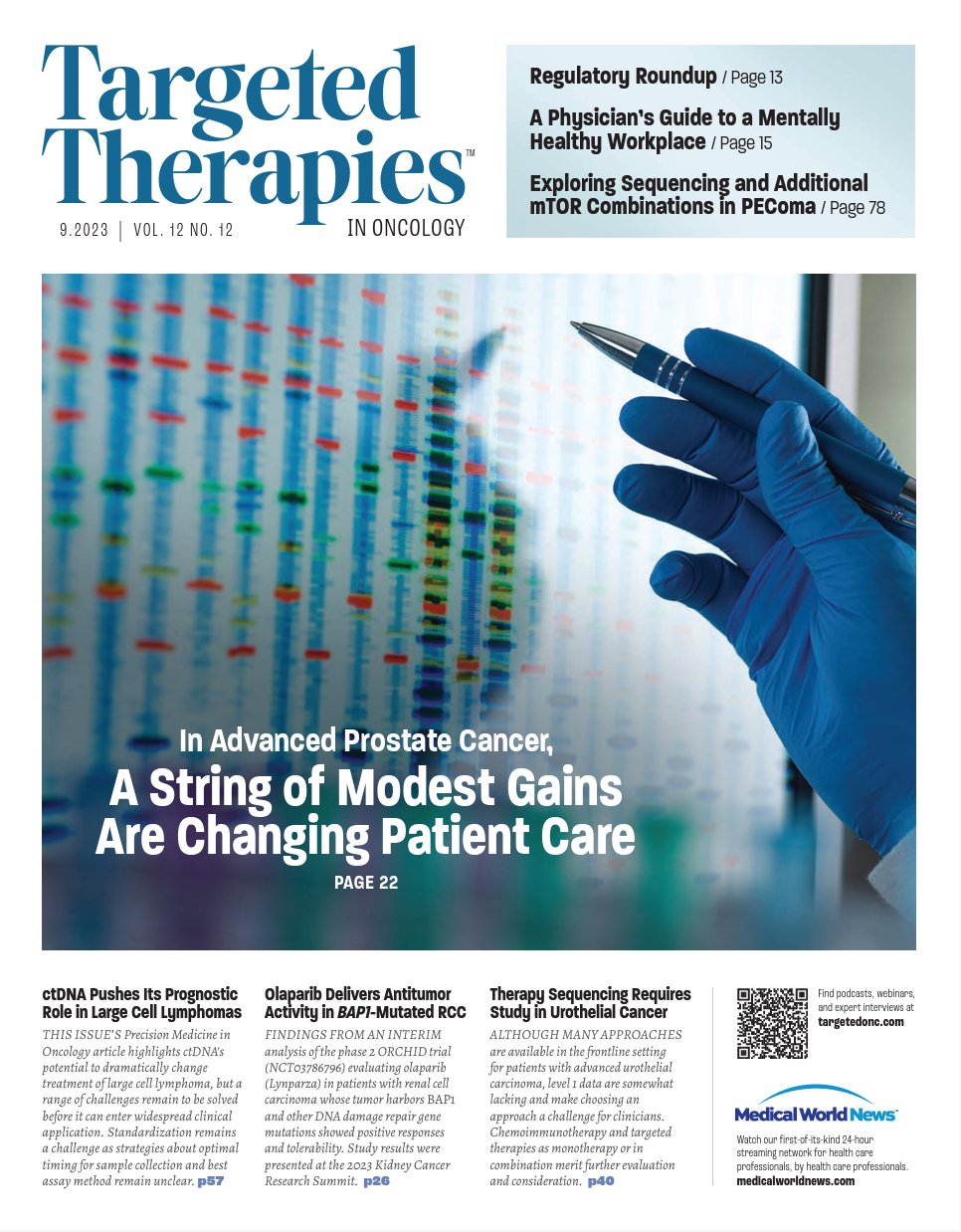Liquid Biopsy: Bringing Transformational Change to Care Across Cancer Settings
Liquid biopsy is offering a noninvasive, real-time, and personalized approach to tumor assessment, and is already revolutionizing the field of clinical oncology.
Manmeet Ahluwalia, MD, MBA, FASCO

One of the most significant challenges in treating patients with brain cancer–and indeed in some other cancers, as well–remains the ability to determine whether cancer has progressed or returned. With treatment necrosis, pseudoprogression, and brain tumor recurrence sharing a similar appearance on conventional follow-up imaging, as well as a patient population that is often unable to undergo additional surgical biopsy without great risk, the search for new options to help differentiate the possibilities is underway. Fortunately, with further study and refinement of liquid biopsy technology, an emerging technology across cancer settings, we now find ourselves in the midst of a transformative change in the landscape of cancer care.
Liquid biopsy tests, which measure circulating tumor in a patient's blood, have already been applied to several different cancer types and have spawned a thriving research community.1 They not only offer a minimally invasive alternative to traditional biopsy, but they also provide enhanced detection and continuous monitoring of cancer.2
Advances in the sequencing of the human genome have made it possible to perform molecular diagnostic testing using a simple blood test. Since the FDA's approval in 2016 of the first liuid biopsy test, research has rapidly moved forward.3 In 2019, liuid biopsy tests were developed as an early detection test for multiple cancer types, and in 2020, they were used to detect cancer mutations in microscopic fragments of DNA or RNA in a patient's blood.3,4
A year later, the approved a liquid biopsy test for monitoring patients with cancer.5 In 2022, with the rapid evolution of methods that allowed for improved isolation and analysis of liquid biopsies, greater detail about tumor characteristics, such as tumor progression, tumor stain, heterogeneity, gene mutations, and clonal evolution, became possible.2
With the progression of research, we have been able to further define the advantages for patients and care teams. In addition to their noninvasive nature, liquid biopsy benefits include the following:
- Real-time monitoring of the tumor, which can help distinguish between disease progression and pseudoprogression and is especially useful in cases where traditional imaging techniques are inconclusive6,7
- Early detection when compared with traditional imaging techniques, which can lead to earlier treatment and better outcomes7
- Continuous monitoring, allowing physicians to adjust treatment plans as needed8
- Personalized treatment based on information about the specific genetic mutations drivin the tumor2
- Identification of treatment resistance by verifying genetic alterations and molecular changes that contribute to treatment resistance6
Additional research is needed to optimize the technique and validate its clinical utility, a point made by the Response Assessment in Neuro- Oncology group's international task force that was charged with reviewing the literature on liquid biopsy use in gliomas. Our report concluded that liquid biopsy is a promising tool for the diagnosis and monitoring of gliomas, and that standardization in biofluid collection and choice of an analyte, as well as other strategies, must be uniform.8
Liquid Biopsy Clinical Trials
In addition, the field of liquid biopsy in brain tumors is evolving and research is expanding its potential applications. There are several clinical liuid biopsy trials currently underway. The Miami Cancer Institute is one of the sites offering the prospective IRT trial (NCT05383872). The ongoing study, which is currently enrolling patients, aims to illustrate the clinical use of liquid biopsy enhanced by low-intensity focused ultrasound technology in patients with brain cancer and provide valuable insights into the clinical utility of the approach.9
Collaboration
A vital component of the research is collaboration between oncologists, radiation oncologists, neurologists, and neurosurgeons. Because such research involves a range of technical and clinical expertise, such collaboration helps ensure that all aspects of the research are covered and that the results are clinically relevant, accurate, and applicable to patient care.10 There are some selected ongoing liquid biopsy studies that include the following
- Precompetitive Collaboration on Liquid Biopsy for Early Cancer Assessment, an initiative aimed at addressing the challenges and designed to accelerate progress in the implementation of liquid biopsy technologies for early cancer detection. The goal is to develop noninvasive or minimally invasive methods to screen for cancer in asymptomatic individuals at normal or high risk.11
- Liquid Biopsy-informed Precision Oncology Study to Evaluate Utility of Plasma Genomic Profiling for Therapy Selection, in which the purpose is to evaluate the feasibility and clinical utility of using liquid biopsy to guide therapy selection in patients with cancer.12
Good candidates for liquid biopsy include patients who cannot undergo traditional tissue biopsy, those with metastatic cancer, patients requiring continuous monitoring, and those whose tumors are in challenging locations where traditional biopsies may be difficult or risky to perform. Liquid biopsy is offering a noninvasive, real-time, and personalized approach to tumor assessment, and is already revolutionizing the field of clinical oncology. It is our hope that continued research will give this new technology a solid place in our toolbox for the fight against cancer.
REFERENCES:
1. Li le L. The history and development of liquid biopsy. Front Line Genomics. January 31, 2023. Accessed August 1, 2023. https://bit.ly/3YOq4kV
2. Lone SN, Nisar S, Masoodi T, et al. Liquid biopsy: a step closer to transform diagnosis, prognosis and future of cancer treatments. Mol Cancer. 2022;21(1):79. doi:10.1186/ s12943-022-01543-7
3. The history of liquid biopsy assays. LabCE. Accessed August 1, 2023. h ps://bit.ly/3OUIhtq
4. Morgan TM. Liquid biopsy: where did it come from, what is it, and where is it going? Investig Clin Urol. 2019;60(3):139141. doi:10.4111/icu.2019.60.3.139
5. Cavallo J. The evolution of liquid biopsy in cancer care. ASCO Post. October 10, 2021. Accessed August 1, 2023. https://bit.ly/447iouW
6. Eibl RH, Schneemann M. Liquid biopsy and primary brain tumors. Cancers (Basel). 2021;13(21):5429. doi:10.3390/ cancers13215429
7. Cameron JM, Brennan PM, Antoniou G, et al. Clinical validation of a spectroscopic liquid biopsy for earlier detection of brain cancer. Neurooncol Adv. 2022;4(1):vdac024. doi:10.1093/noajnl/vdac024
8. Soffietti R, Bettegowda C, Mellinghoff IK, et al. Liquid biopsy in gliomas: a RANO review and proposals for clinical applications. Neuro Oncol. 2022;24(6):855-871. doi:10.1093/ neuonc/noac004
9. Snow A, Chen D, Lang JE. The current status of the clinical utility of liquid biopsies in cancer. Expert Rev Mol Diagn. 2019;19(11):1031-1041. doi:10.1080/14737159.2019.1664290
10. Brennan PM. The future of brain tumor liquid biopsies in the clinic. Neurooncol Adv. 2022;4(suppl 2):ii4-ii5. doi:10.1093/noajnl/vdac091
11. Precompetitive collaboration on liquid biopsy for early cancer assessment: data management and coordinating unit (U24 clinical trial not allowed). Department of Health and Human Services. March 14, 2023. Accessed August 1, 2023. https://bit.ly/3OSkF8O
12. Tao J, Canzoniero JV, Fa eh M, et al. Liquid biopsy-informed precision oncology study to evaluate utility of plasma genomic profi ling for therapy selection. J Clin Oncol. 2023;41(suppl 16):TPS1616. doi:10.1200/JCO.2023.41.16_suppl. TPS1616

Advances in Subsequent Therapies Shake Up Sequencing of ccRCC Treatment
April 25th 2024With the approval of belzutifan and other newer data for treating patients with recurrent renal cell carcinoma, the state of subsequent therapies is advancing beyond the reuse of frontline options with impacts on duration of response and quality of life.
Read More